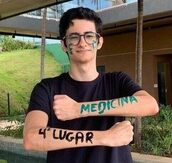Unilago 2014/2
Leia o texto a seguir e responda à questão.
Autism spectrum disorder (ASD) is a range of complex neurodevelopment disorders, characterized by social impairments, communication difficulties, and restricted, repetitive, and stereotyped patterns of behavior. Autistic disorder, sometimes called autism or classical ASD, is the most severe form of ASD, while other conditions along the spectrum include a milder form known as Asperger syndrome, and childhood disintegrative disorder and pervasive developmental disorder not otherwise specified. Although ASD varies significantly in character and severity, it occurs in all ethnic and socioeconomic groups and affects every age group. Experts estimate that 1 out of 88 children age 8 will have an ASD. Males are four times more likely to have an ASD than females. The hallmark feature of ASD is impaired social interaction. Children with an ASD may fail to respond to their names and often avoid eye contact with other people. They have difficulty interpreting what others are thinking or feeling because they can’t understand social cues, such as tone of voice or facial expressions. Many children with an ASD engage in repetitive movements such as rocking and twirling, or in self-abusive behavior such as biting or head- -banging. They also tend to start speaking later than other children. Scientists aren’t certain about what causes ASD, but it’s likely that both genetics and environment play a role. Researchers have identified a number of genes associated with the disorder. Studies of people with ASD have found irregularities in several regions of the brain. Other studies suggest that people with ASD have abnormal levels of serotonin or other neurotransmitters in the brain. These abnormalities suggest that ASD could result from the disruption of normal brain development early in fetal development caused by defects in genes that control brain growth and that regulate how brain cells communicate with each other, possibly due to the influence of environmental factors on gene function. The theory that parental practices are responsible for ASD has long been disproved. For many children, symptoms improve with treatment and with age. Children whose language skills regress early in life – before the age of 3 – appear to have a higher than normal risk of developing epilepsy or seizure-like brain activity. People with an ASD usually continue to need services and supports as they get older, but many are able to work successfully and live independently or within a supportive environment.
(Adaptado de: http://www.ninds.nih.gov/disorders/autism/detail_autism.htm. Acesso em: 1 mar. 2014.)
Com base no texto, considere as afirmativas a seguir.
I. Em “while other conditions along the spectrum”, a palavra sublinhada introduz uma ideia de concomitância entre as ações.
II. Em “Although ASD varies significantly in character and severity”, a palavra sublinhada introduz um questionamento.
III. Em “how brain cells communicate with each other”, a expressão sublinhada estabelece uma relação de reciprocidade.
IV. Em “ASD could result from the disruption of normal brain development”, o verbo modal sublinhado indica uma possibilidade.
Assinale a alternativa correta
Somente as afirmativas I e II são corretas.
Somente as afirmativas I e IV são corretas.
Somente as afirmativas III e IV são corretas.
Somente as afirmativas I, II e III são corretas.
Somente as afirmativas II, III e IV são corretas.
Tudo com nota TRI em tempo real


